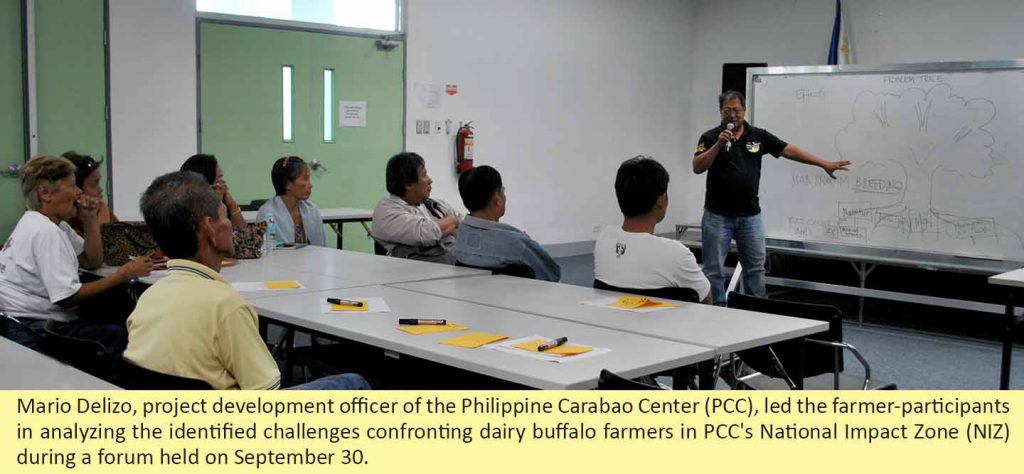Dairy farmers in the National Impact Zone (NIZ) of the Philippine Carabao Center (PCC) need to enhance the milk production performance of their dairy buffaloes in order to further improve their income from their respective buffalo-based enterprises.
This was the focal point of the dairy forum conducted on September 30 by PCC’s Dairy Herd Improvement (DHI) team at the NIZ at the PCC national headquarters in the Science City of Muñoz, Nueva Ecija.
Some 50 officials from the different PCC-assisted dairy cooperatives in Nueva Ecija, which is the NIZ of the PCC’s Carabao Development Program, participated in the one-day activity.
They interacted with the forum panel that comprised Dr. Arnel N. Del Barrio, acting executive director of PCC; Dr. Daniel Aquino and Dr. Tsutomo Fujihara, nutrition experts; Dr. Peregrino Duran, breeding expert, and Patricia Saturno, plant manager of PCC’s Central Milk Processing Plant.
“You may already be earning income from dairying now but we have yet to reach the optimized level of productivity of the dairy buffaloes. This may be due to some challenges that beset the different aspects of production and management,” Dr. Del Barrio said in his opening remarks.
“This forum is therefore an opportunity for us to identify these issues and analyze their root causes, discuss these and recommend solutions so that we can improve the present condition of our dairy enterprises,” he explained.
Data from DHI team show that as of August, 2014, there are about 3,000 purebred dairy buffaloes in the hands of small-hold dairy farmers in the NIZ. About 33% of these are cows, 32% of which are in the milking line. Of the more than 2,000 breedable females, 24% are pregnant.
As part of the activity, the participants identified the various gaps in the different aspects of carabao and milk production, such as breeding, health and nutrition, and milk handling that are inhibiting the buffaloes from attaining their full dairy potential.
Some of the issues that came up were low pregnancy rate among heifers and cows resulting in long calving intervals. Problems related to milk production also surfaced.
On the health aspect of the animals, the farmers are confronted with incidence of diseases, such as parasitism and mastitis.
The participants were encouraged to share their insights and to suggest possible courses of action to address each of the issues.
“Over the past 20 years, PCC has developed various technologies on different areas of buffalo management which may help in increasing milk production. We are sharing them to you and we encourage you to adopt and apply them,” Del Barrio said.
The panelists stressed the importance of proper feeding management in relation to milk production.
“When you give the right amount of balanced food to your animals, they will give you back the desired amount of milk,” Aquino stressed.
He urged the participants to practice the “challenge feeding” technique.
“Immediately after the cow gives birth, add two kilos of dairy concentrate to the food of the cow daily. With every kilo of milk added to the milk production, add another half kilo on top of the two kilos of concentrate. The challenge lasts for 70-90 days from calving or until the cow has reached its production peak,” Aquino added.
Regarding buffalo health concerns, the panelists pointed out that the incidence of diseases may be avoided by proper care and management of the animals, such as the practice of cut-and-carry feeding scheme instead of grazing. This will minimize the chance of the buffalo to contract parasites that cause diseases, such as liverfluke.
For her part, Saturno emphasized the importance of proper milk handling in order to ensure the quality of milk.
In his closing remarks, Dr. Del Barrio urged the farmers to double their milk production by next year.
“I believe that we can achieve this when we work together. We already have the knowledge, we know the solution. All we need is action,” Dr. Del Barrio said.

